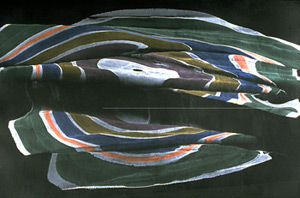 Amy Lee Segami is a Chicagoland painter and the latest featured artist in our ongoing exhibition series Local Art @ EPL. Her show Frozen Dreams: Painting on Water is currently on display on the 2nd floor of EPL’s Main Library where you can catch it through March 7th. Weaving her backgrounds in art and science with Eastern and Western perspectives, Segami draws on her Asian heritage and physics knowledge for her contemporary take on the ancient art form Suminagashi. We recently spoke with her via email about the fusion of art and science, the 2,000-year history of Suminagashi, her creative process, and her future plans.
Amy Lee Segami is a Chicagoland painter and the latest featured artist in our ongoing exhibition series Local Art @ EPL. Her show Frozen Dreams: Painting on Water is currently on display on the 2nd floor of EPL’s Main Library where you can catch it through March 7th. Weaving her backgrounds in art and science with Eastern and Western perspectives, Segami draws on her Asian heritage and physics knowledge for her contemporary take on the ancient art form Suminagashi. We recently spoke with her via email about the fusion of art and science, the 2,000-year history of Suminagashi, her creative process, and her future plans.
Evanston Public Library: Can you tell us a little about your background as an artist? How did you get started in art? Was there something specific in your life that sparked a need to create? What drove you in the beginning? What drives you now?
Amy Lee Segami: Although I had dreamed of being an artist as a young child, my father would not allow me to explore the creative path. I had to put my dream on hold. I had to freeze it. He guided me down the road of science and physics. It was not until I fulfilled his wishes to have a secure place in society as a professional that I was free to explore my frozen dream.
Then again, I would not be able to create the work that I do now if I did not have my science knowledge in the first place. My work is a true fusion of art and science, as well as Eastern and Western culture.
What drove me in the beginning was to find a way that would allow me to combine my science knowledge and passion, instead of them being competing factors. What drives me now is to share the idea of collaboration and co-existence with others. Completely opposite elements could work together. When you combine the most extreme opposite elements together, magic happens. In fact, competition creates collaboration and through collaboration, the team wins the competition. It’s much like the yin and yang concept in China.

EPL: Can you tell us about the 2,000-year history of Suminagashi? Why was it almost lost?
ALS: Suminagashi means flowing ink. It was practiced by the Shinto priests in Japan 2,000 years ago. This once sacred art was only presented to the noblemen, shoguns and the Emperor for viewing. During religious ceremonies, the art would be burned as offerings to the gods. Unlike other art forms the pieces were not created to be collected or displayed. That’s why it’s a nearly lost art. Very few people know about Suminagashi so it’s exciting for me to share what I have learned.
EPL: Can you give us a window into your creative process? How did you develop your “Painting on Water” technique?
ALS: Being trained as a mechanical engineer, I developed my process in a very methodical and systematic way. I explored the density of the ink, tested the viscosity of the water, documented the humidity of the studio, and verified the absorbance of different kinds of paper. It was pretty comprehensive, I must say.
The hard work paid off as I was able to create one of a kind painting that has never been done before. Due to the fluidity of the water as canvas, I could achieve the result of a three dimensional look on a flat surface. The other major difference is I have turned a black and white traditional art form into my own colorful contemporary form of Suminagashi I call Painting On Water™.

EPL: What are your future goals and plans as an artist?
ALS: After spending years on research and development in my studio lab, I have a body of work to share with the rest of the world. My dream is to have an international traveling exhibition around the globe. Art is a form of international message. The images from Painting On Water™ transcend language and cultural differences.
EPL: How do you find Evanston and the Chicagoland area as a place to work and exhibit as an artist? What inspires you as an artist about the community where you live?
ALS: Chicagoland is the ultimate place for arts and science to thrive and co-exist, from the Art Institute and the Museum of Contemporary Art to Fermilab and Argonne. As I call Chicago my second home, I could not be more pleased with the inspiration from the area. Evanston holds a very special place in my artistic career. 25 years ago, my very first exhibition was held in the North Shore. The Evanston Review gave me the very first interview and published the article to spread the word. One could say my artistic career was launched from Evanston. It means a lot that I revisit Evanston and am able to exhibit at the Evanston Public Library.
Interview by Russell J.
